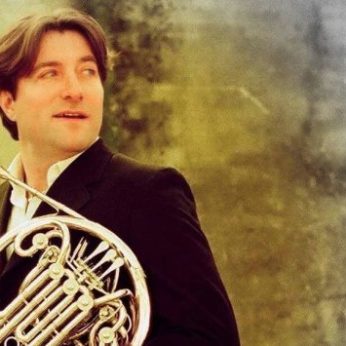Composer: Ludwig van Beethoven (b. 1770 - d. 1827)
Performance date: 06/07/2012
Venue: St. Brendan’s Church
Composition Year: 1800
Duration: 00:14:22
Recording Engineer: Anton Timoney, RTÉ lyric fm
Instrumentation: 2vn, va, vc
Instrumentation Category:Duo
Artists:
Paavali Jumpannen -
[piano]
Hervé Joulain -
[horn]

As its
Opus Number indicates this is an early work by Beethoven and dates from the
fruitful year of 1800 which also saw the completion of his First Symphony, as
well as the delightful Septet and the Op.18 String Quartets. Beethoven dedicated it to Baroness Josefine
von Braun, the wife of the manager of the Theater-an-der-Wien. The player for
whom he had written the work, Giovanni Punto [1746-1803], was far better known
at this time than he was and one newspaper commented when they appeared
together at the première on April 18th: “Who is this Beethoven?” Punto’s
real name was Jan Vaclav Stich and he was a popular performer at the time.
According to Beethoven’s friend Ferdinand Ries, Beethoven only wrote the Sonata
the day before the concert. Whatever about his own skills, Punto must have been
either a great sight-reader or a remarkably quick learner as the horn part is
quite challenging. They played it again at a fund-raising concert the following
January in aid of the wounded from the disastrous Battle of Hohenlinden and it
was published later that year. Much
later in 1814 Beethoven made a rare public appearance accompanying the horn
player of the court orchestra, Friedrich Starke [1774-1835], in the Sonata. It
was discovered that the piano was a half-tone too low, so he transposed it at
sight effortlessly and then added a number of improvisations to the event.
The
Sonata is a charming work, uncomplicated and tuneful. There is an unusual key change in the first
movement (to E minor) but otherwise it is a cheerful affair with the horn
opening proceedings with a hunting call on its own. The second subject is also
announced by the horn, a melancholic tune.
The very brief slow movement introduces a soulful melody intended to
display the legato line of the horn. The pace quickens and the finale follows
without a break. This is a rondo launched by the piano with the horn quickly
repeating the jolly tune. The episodes between the return of the theme provide
ample scope for the horn and keyboard to display their talents
Copyright © 2024 West Cork Music. All rights reserved.
Designed and developed by Matrix Internet